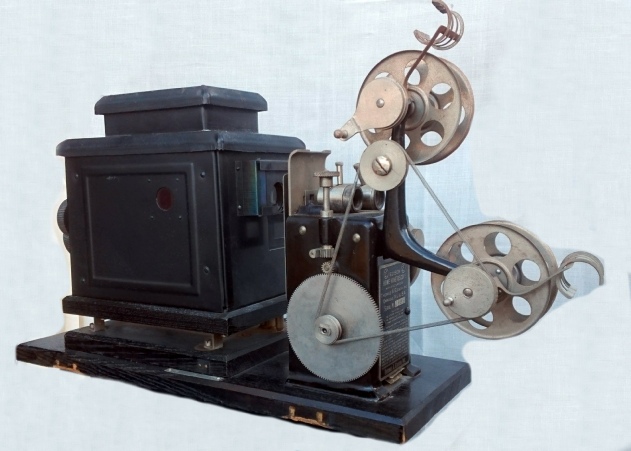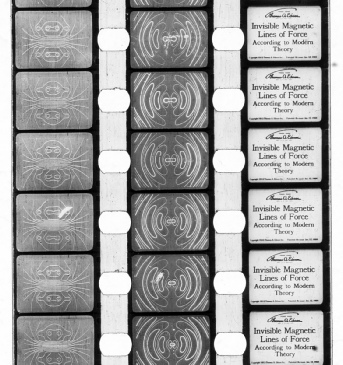Kinetoscope films have three rows of images each approximately 6mm by 4mm inter spaced by rows of perforations. The complete film is viewed by running it through the projector three times. To make this possible the gate aperture and lens assembly can be moved into three different positions by the rotation of a knob located on top of the motion head. The lamphouse can also be moved sideways to line up with the frame of film being projected, or to illuminate a glass slide holder and lens assembly located along side the motion head.
In operation the row of images nearest the operator is projected first, the gate, lens and lamphouse are then moved to the central position and the central row of images are then projected, this time cranking the machine backwards. Finally the third row is projected again in the forward direction. Upon completion the film is rewound onto the feed spool by means of a small handle attached to the spool arm.
Promotional material for the Kinetoscope claimed 8 feet of this film contained as many pictures as 100 ft of the film used in theatres (35mm) and gives as long a performance about 10 minutes. Films ranged from 10 to 30 ft in length and appear to have been reduction prints from Edison 35mm theatrical releases covering both entertainment and documentary subjects.
It was claimed a library of over 250 titles existed at the time the Kinetoscope was introduced. Films were sold outright at prices ranging from $2.50 to $20, depending on length. An exchange plan also operated whereby films could be sent to the Edison Company in Orange, New Jersey for exchange. Coupons to pre-
By modern standards the projected picture is fair, and approximates that produced by the average Standard 8mm projector in both brightness and definition. Because the machine has no shutter some vertical streaking is present in the picture.
The Kinetoscope’s use of safety film was a big step in the right direction for the home showman, yet the dangers associated with the use of a carbon arc lamp, to say nothing of the optional acetylene generator, in the home by an inexperienced operator seems to have been ignored.
No attempt to produce a camera or provide any service for the amateur moviemaker has been documented. (C) 2019 Mike Trickett Gelong Australia
The Edison Home Kinetoscope was not a commercial success, something less than 2,000 were sold and this well made little machine seems to have faded from the scene after only a few years. They are now considered to be a very collectible piece of home movie history
Of the half dozen or so home Kinetoscopes that I have seen, all have been fitted with the baby carbon arc and the machine I have in my collection is no exception. The small lamphouse relies on natural ventilation and judging by the scorching inside most machines they would appear to get very hot in operation. The arc was powered directly for the American 120-
It was claimed in the owner’s handbook that a picture six feet wide from a throw of 30 feet could be obtained; brightness level was conveniently not mentioned. An intermittent sprocket located just below the gate provides the film transport. Upper and lower spring loaded arms are used to smooth out the motion of the film. The film is threaded between the rear hinged pressure plate and the gate through a chute under the motion head and then to the take up spool. A small detachable arm for hand cranking fits to the main drive shaft. The projector does not have a shutter, relying instead on the rapid pull down produced by the intermittent. There is a centrifically operated safety shutter to protect the film should it become stationary in the gate.
The Home Kinetoscope is quite small in size, measuring only 41cm long by 15cm wide and 25cm high. With its detachable film spool arms removed the projector fits neatly into its handsome metal case, which also doubles as a projection stand.
The handbook for the home Kinetoscope shows it being available with three different lighting systems; an acetylene generator and burner for locations without electricity, a Nernst electric lamp suitable for small screenings and a baby arc lamp for big screen presentations.
The price in 1912 for the Home Kinetoscope ranged from US$65.00 to US$97.50 depending on lighting and lens combinations.
THE EDISON HOME KINETOSCOPE
The demand for home movies it seems can be traced rightback to the earliest days of the cinema. As early as 1900, enterprising manufacturers had found that by slitting the standard 35mm film down the middle, the cost of making movies for the home screen could be reduced considerably. This technique while reducing the costs involved continued to use the highly flammable nitrate film of the time.
In 1912, Thomas Edison entered the home movie scene with the introduction of the Edison Home Kinetoscope. This little hand-
George Eastman (Kodak) had some years earlier developed cellulose acetate film as an alternative to nitrate, but it gained little acceptance at the time with professional users. All Home Kinetoscope films were printed on this new safety film, this point was used extensively in the advertising and promotion of the machine. It was Edison’s boast that the machine was safe in the hands of even the most inexperienced operator.
A past article from the pages of
Reel Deals
The Australian Film Collectors’ Magazine



Right: Edison 22 mm Film, showing the 3 rows of images.